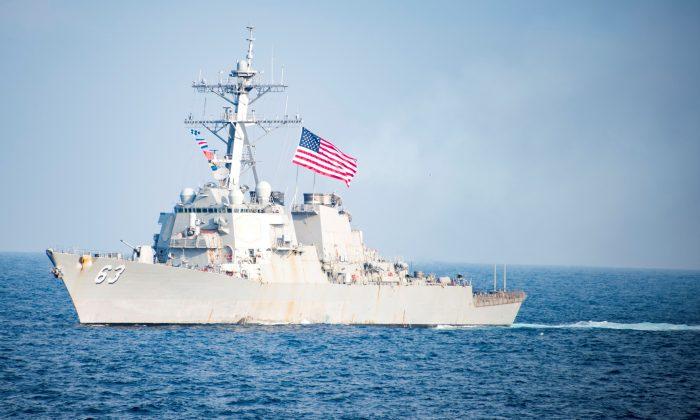The U.S. Navy has ordered that all its ships that have recently visited any country in the Pacific region are to remain at sea for 14 days—effectively putting them in quarantine in efforts to curb the spread of the new coronavirus disease.
US Navy spokesman Lt. James Adams
told CNN that so far there are no signs that any U.S. Navy personnel have contracted the disease, but the action is precautionary.
“Out of an abundance of caution, Pacific Fleet is implementing additional mitigations to prevent Sailors from contracting COVID-19, and to monitor Sailors who have traveled to higher-risk areas,” Adams told the network.
“The health and welfare of our sailors, civilians and their families is paramount and our efforts are directed at detection and, if required, prevention of the spread of this illness,” he added.
During the two weeks, soldiers will be monitored for any symptoms of the new virus. The most common symptoms of the virus are fever, coughing, and difficulty breathing, although Chinese researchers have noted other symptoms, such as fatigue, diarrhea, chest pains, and headaches.
The incubation period—or amount of time from exposure to the onset of symptoms—has been widely reported as up to 14 days. However, a recent study from Chinese researchers, which examined over 1,000 cases of the disease, found patients might not exhibit symptoms for
as long as 24 days.
COVID-19 has spread to more than 40 countries around the world, and cases and deaths related to the coronavirus continue to increase daily. The new coronavirus was first reported in early December 2019 and originated in Wuhan, in China’s Hubei Province. The virus is in the same family of pathogens that cause the flu and SARS (severe acute respiratory syndrome).
The latest decision from the U.S. Navy comes as the United States and South Korea decided to
postpone joint military exercises until further notice, according to a United States Forces Korea announcement
posted Thursday. The decision was in response to the South Korean government’s recent decision to increase its coronavirus alert level to “severe”—the highest of four levels in the country. South Korea now has more than 2,000 cases.
Meanwhile, in the Middle East, the U.S. Central Command (CENTCOM) is restricting certain types of travel for U.S. troops within its area of responsibility across the Middle East and southwest Asia, citing coronavirus concerns, according to a memo (
pdf) obtained by
Politico. This includes the cancellation of all leave and liberty travel for U.S. service members overseen by CENTCOM, until further notice.
In Europe, U.S. military bases in Vicenza, Italy, have seen
closures of on-base schools, child care centers, gyms, and religious services, and more, until at least March 1, according to a
U.S. Army announcement on Tuesday, Feb. 24, as the disease spreads across Italy. The closures, which are precautionary actions to curb the spread of the coronavirus, may be extended. Military personnel in Vicenza are also banned from nonessential travel to Lombardy and Vo’ Euganeo—areas where there are clusters of coronavirus cases. No cases have been confirmed in Vicenza.
Inside the United States, California is
monitoring some 8,700 people and a county in New York State is
monitoring about 700 people for possible coronavirus. The United States has a total of 60 confirmed cases of the virus, 42 of which originated from passengers from the Diamond Princess cruise ship that was quarantined off Yokohama, Japan, earlier this month.
Three of the 60 cases were in those who were evacuated from Wuhan. The remaining 15 cases were detected in six states—Arizona, California, Illinois, Massachusetts, Washington, and Wisconsin—with
the 15th case northern California possibly being the first case of human-to-human transmission from an unknown source, according to the
U.S. Centers for Disease Control.
Eva Fu contributed to this report.





